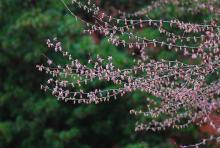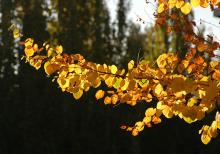Cercidiphyllum japonicum
Common name:
Katsura
Katsuratree
Pronunciation:
ser-si-di-FIL-um ja-PON-i-kum
Family:
Cercidiphyllaceae
Genus:
Type:
Broadleaf
Native to (or naturalized in) Oregon:
No
- Broadleaf deciduous tree, 40-60(100) ft [12-18(30) m] high, pyramidal when young. Leaves simple, opposite or subopposite and occasionally alternate, purplish tan when unfolding, then finally bluish-green, are rounded, heart-shaped (resembling Cercis canadensis), 5-10 cm long, neatly spaced in pairs along arching branches. Supposedly develops a "soft apricot-orange color" in fall, but not spectacular in Corvallis. Dioecious, i.e., male and female flowers on different plants. Male flowers appear in spring before the leaves, female flowers appear later, usually as the leaves expand, neither is considered showy. Fruit a small narrow pod, 2.5 cm long.
- Sun, but probably best in light shade. Grows best in moist well-drained soil, pH adaptable, but supposedly has better fall color in acid soils, needs supplemental watering. Bark splitting and sun scald may occur. In Corvallis, we frequently observe deformed young leaves for a period in the spring, night frosts are suspected.
- Hardy to USDA Zone 4 Native to China and Japan.
- Two weeping forms are available: 'Amazing Grace' and C. j. f. pendula and a purple-leaved selection, 'Red Fox'.
- Cercidiphyllum: refers to the similarity of its leaves (phyllum) with those of Cercis. japonicum: of Japan.
- Oregon State Univ. campus: front of Shepard Hall and nearby Dearborn Hall, both male and female trees.
Click image to enlarge





















